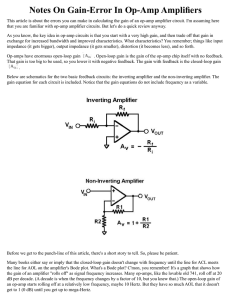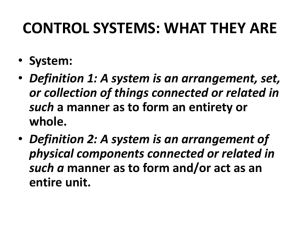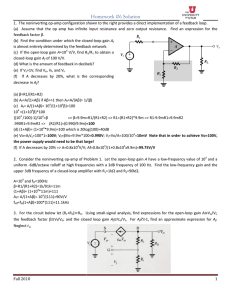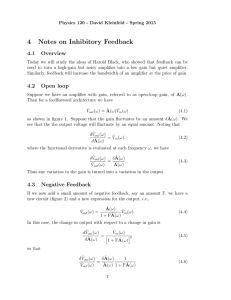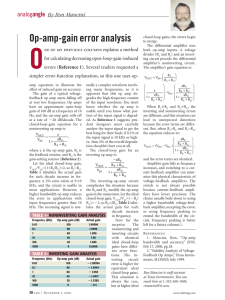OP-Amp OPEN-LOOP RESPONSE
advertisement
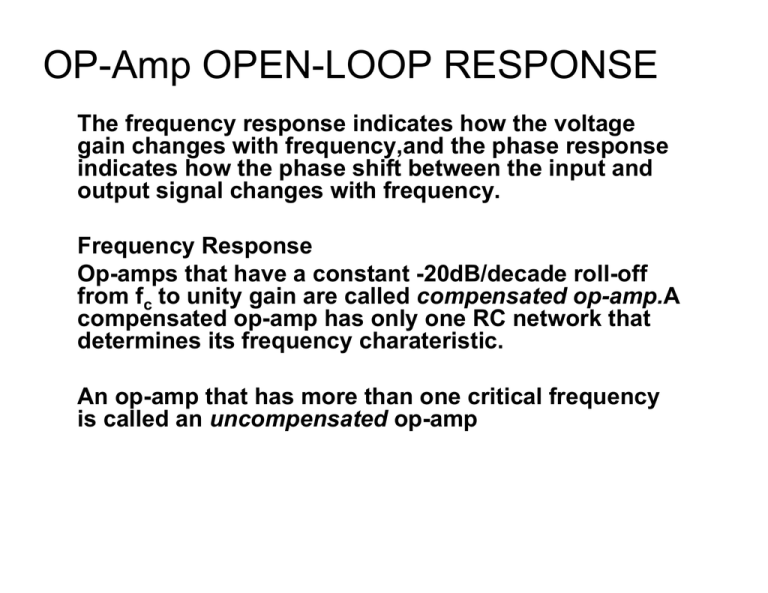
OP-Amp OPEN-LOOP RESPONSE The frequency response indicates how the voltage gain changes with frequency,and the phase response indicates how the phase shift between the input and output signal changes with frequency. Frequency Response Op-amps that have a constant -20dB/decade roll-off from fc to unity gain are called compensated op-amp.A compensated op-amp has only one RC network that determines its frequency charateristic. An op-amp that has more than one critical frequency is called an uncompensated op-amp Aol - R1 AV1 + C1 Op-amp Av2 R2 C2 R3 Av3 + C3 Op-amp Representation of an op-amp with three internal stages A’v (dB) Av1 Av2 Av3 0 fc1 fc2 Individual Response fc3 f Av(dB) Av1+Av2+Av3 -20dB/decade -40dB/decade 75 50 25 0 -60dB/decade 1 fc1 fc2 fc3 Composite response for an uncompensated op-amp f(Hz) Op-Amp have a frequency range with starts at 0Hz.At the upper end,the frequency range is limited by the bandwidth and the slew rate. The gain decreases with increasing frequency. • The gain decreases after first critical frequency with a slope of 20dB/decade,after the second critical frequency with a slope of -40dB/decade and etc. PHASE RESPONSE Phase response indicates how the phase shift between i/p and o/p signal changes with frequency. With increasing frequency,a growing phase shift will occur between i/p & o/p In a multistage amplifier,each stage contributes to the total phase lag.Each RC lag network can produce up to a -90o phase shift. f −1 f −1 f φtotal = −tan − tan − tan fc1 fc2 fc3 −1 Example A certain op-amp has three internal amplifier stages with midrange gains of 30dB,40dB and 20dB.Each stage also has a critical frequency associated with it as follows: fc1=600Hz,fc2=50kHz and fc3=200kHz. (a) What is the midrange open-loop gain of the opamp,expressed in dB (b) What is the total phase shift through the amplifier,including inversion,when the signal frequency is 10 kHz. Answer (a ) Aol ( mid ) = 30dB + 40dB + 20dB = 90dB f 10kHz 0 (b) φ1 = − tan −1 = − tan −1 = −86.6 600 Hz fc φ 2 = − tan −1 f 10 kHz 0 = − tan −1 = − 11 .3 50 kHz fc f −1 10kHz 0 φ3 = − tan = − tan 2 . 9 = − 200kHz fc −1 φtot = −86.6 0 − 11.30 − 2.9 0 − 180 0 = −2810 Op-AMP CLOSED-LOOP RESPONSE RECALL FOR NON INVERTING AMPLIFIER ACL ( NI ) = Rf Ri + 1 For the Voltage Follower , Acl (VF ) ≅ 1 For the inverting amplifier, Rf Acl ( I ) ≅ − Ri Effect of Negative Feedback on Bandwidth. The closed-loop critical frequency of an opamp is f c(cl) = f c(ol) (1 + BAol(mid) ) fc(cl) is higher than the open loop critical frequency fc(ol) by the factor 1+BAol(mid).Recall that B is the feedback attenuation, Ri/(Ri +Rf).Since fc(cl)equals to bandwidth for the closed-loop amplifier,the bandwidth is also increased by the same factor. BWc ( cl ) = BWol (1 + BAol ( mid ) ) EXAMPLE A certain amplifier has an open-loop gain in midrange of 180,000 and an open-loop critical frequency of 1500Hz. If the attenuation of the feedback is 0.015,what is the closed-loop bandwidth? Solution BWcl = BWol (1 + BAol ( mid ) ) = 1500 Hz[1 + (0.015)(180,000)] = 4.05 MHz Closed-Loop vs Open-loop Gain Av Open-loop gain Aol(mid) Closed-loop gain Acl(mid) fc(ol) fc(cl) f When the open-loop gain of an op-amp is reduced by negative feedback,the bandwidth is increased. The closed-loop gain is independent of the open-loop gain. The point of intersection is the critical frequency,fc(cl),for the closed-loop response.The closed-loop gain has the same roll-off rate as the open-loop gain. Gain –Bandwidth product An increase in closed-loop gain causes a decrease in the bandwidth and viceversa,such that the product of gain and bandwidth is a constant.This true as long as the roll-off rate is fixed -20dB/decade If Acl represents the gain of any of the closed-loop configurations and fc(cl) represents the closed-loop critical frequency. Aclfc(cl)=Aolfc(ol)=Unity gain bandwidth The gain-bandswidth product is always equal to the frequency at which the opamp’s open-loop gain is unity Aclfc(cl)=unity-gain bandwidth Op-Amp Bandwidth • Open-loop bandwidth: BWol = fc(ol) • Closed-loop critical frequency: fc(cl) = fc(ol)(1 + BAol(mid)) • Since fc(cl) = BWcl , the closed-loop bandwidth is: BWcl = BWol(1 + BAol(mid)) • Gain Bandwidth Product is a constant as long as the roll-off rate is fixed: Aclfc(cl) = Aolfc(ol) = unity-gain bandwidth Example For each amplifier determine the closed-loop gain and bandwidth. The op-amps in each circuit exhibit an open-loop gain of 125dB and a unity-gain bandwidth of 2.8MHz. Rf Vin Vin − Vout + Rf=12k Ri=1.0k (a) Ri 5.6k 1.0M − Vout + (b) − Vout Rf + Ri Vin 2.2K Vin 100K − Vout + 2.2K (c ) (d) SOLUTION BWAcl=UNITY GAIN BANDWIDTH 12k = 13 (a ) Acl ( NI ) = 1 + 1k 2.8MHz BW = 13 (b ) Acl ( I ) 1M =− = − 179 5 .6 k 2 .8 MHZ BW = = 15 .7 KHZ 178 .6 (C) ACL(VF) = 1 BW = fC(CL) Unity− gain BW 2.8MHz = = = 2.8MHz 1 Acl 100K = −45.5 (d ) Acl ( I ) = − 2.2K 2.8MHz BW = = 61.6kHz 45.5 POSITIVE FEEDBACK AND STABILITY Vin − Vout Vf + Internal inversion Makes Vf 1800 out of Phase with Vin. B With negative feedback,the Signal fedback to the input Of an amplifier is out of phase with The input signal,the amplifier is stable. When the signal fedback from output to input is in phase with the output signal,a positive feedback condition exits and the amplifier can oscillate.That is,positive feedback occurs when the total phase shift through the op-amp and feedback network is 3600,which is equivalent to no phase shift(00). Positive Feedback & Stability • Positive feedback, where the output signal being fed back is in-phase to the input, will cause the amplifier to oscillate when the loop gain, AolB > 1. • Phase margin, θpm , is the amount of additional phase shift required to make the total phase shift around the feedback loop 360o. • To ensure stability for all midrange frequencies, an op-amp must be operated with an Acl such that the roll-off rate beginning at fc is -20 dB/decade. LOOP Gain For instability to occur:(a) There must be positive feedback (b) The loop gain of the closed-loop amplifier must be greater than 1. The loop gain of a closed-loop amplifier is defined to be the op-amp’s open-loop gain times the attenuation of the feedback network. Loop Gain =AolB PHASE MARGIN For each amplifier configuration as shown below,the feedback loop is connected to the inverting input.The is an inherent phase shift of 1800 because of the inversion between input and output. Vin − + 180 0 + φtotal R1 R2 Additional phase shift produced by the RC lag network within the amplifier. Rf Ri Vin 180 0 180 − + φ total − + + Vout Vin 0 + φ total Vout The phase margin, φ pm is the amount of additional phase shift required to make the total phase shift around the loop 3600 (3600 is equivalent to 00) 180 + φtotal + φ pm 0 φ pm = 180 − φtotal 0 If the phase margin is positive,the total phase shift is less than 3600,then amplifier Is stable.If the phase margin is zero or negative,the amplifier is potentially unstable Because the signal fed back can be phase with the input. Stability Analysis Av(dB) Aol(mid) -20dB/decade 120 -40dB/decade 100 60 25 -60dB/decade f1 0 1 10 100 1k f2 f3 10k 100k f(Hz) 1M We use an uncompensated three stage opamp with an open-loop response.For this case ,three are three different critical frequencies,which indicate three internal RC lag networks.At first critical frequency,fc1,the gain begins rolling off at -20dB/decade.When the second critical frequency,fc2,is reached,the gain decreases at -40dB/decade;and when the third critical frequency,fc3,is reached,the gain drops at -60dB/decade. To analyze an uncompensated closed-loop amplifier for stability,the phase margin must be determined. CASE 1. Av(dB) Aol(mid) 120 Open loop gain Acl(mid) 106 75 50 25 0 1 10 100 1K 5k 10k 100k 1M f(Hz) Case1 The closed-loop gain intersects the openloop response on the -20dB/decade slope,the midrange closed-loop gain is 106dB,and the closed loop critical frequency is 5kHz. f −1 f −1 f φtotal = − tan − tan − tan f c1 f c2 f3 −1 Where f=5kHz, fc1=1kHz,fc2=10kHz and fc3=100kHz. 5 kHz − 1 5 kHz tan − 10 kHz 1 kHz = − 78 . 7 0 − 26 . 6 0 − 2 . 9 0 = − 108 φ total = − tan −1 − tan .1 0 −1 φTOTAL = 180 − 108.1 = +72 5 kHz 100 kHz CASE 2 The closed-loop gain is lowered to where it intersects the open-loop response on the 40dB/decade slope,the midrange closed-loop gain in this case is 80dB,and the closed-loop critical frequency is approximately 30kHz.The total phase shift at f=30kHz due to three lag network is calculated as follows; 30 kHz φ total = − tan 1kHz = − 88 .1 0 − 71 .6 0 Phase M arg in is −1 −1 30 kHz −1 30 kHz − tan − tan 100 kHz 10 kHz − 16 .7 0 = − 176 .4 0 φ pm = 180 0 − 176 .4 0 = + 3 .6 0 Av(dB) Aol(mid) Open loop gain 120 106 Closed-loop gain Acl(mid) 80 -40dB/decade 50 25 0 1 10 100 1K 10k 30k 100k 1M Case closed-loop gain intersects open-loop gain on 40db/decade f(Hz) The phase margin is positive,so the amplifier is still stable for frequencies in its midrange,but a very slight increase in frequency above fc would cause it to oscillate. Av(dB) Aol(mid) Open loop gain 120 80 50 Closed-loop gain 25 -60dB/decade Acl(mid) 18 0 1 10 100 1K 10k 100k 500k 1M f(Hz) CASE 3 The closed-loop gain is further decreased until it intersects the open-loop response on the -60dB/decade slope,the midrange closed-loop gain is 18dB,and the closed-loop critical frequency is 500kHz.The total phase shift at f = 500kHz due to three lag networks is; 500 kHz −1 500 kHz −1 500 kHz φ total = − tan − tan − tan 1kHz 10 kHz 100 kHz = − 89 .9 0 − 88 .9 0 − 78 .7 0 = −257 .5 0 Phase M arg in is −1 φ pm = 180 0 − 257 .5 0 = −77 .5 0 Phase Margin is negative and the amplifier is unstable at the upper end of its midrange. EXAMPLE 1 (a)It has been determined that the op-amp circuit in Figure below has three internal critical frequencies as follows: 1.2kHz,50kHz,250kHz.If the midrange open-loop gain is 100dB,is the amplifier configuration stable,marginally stable or unstable? (b) Determine the phase margin for each value of phase lag. (i) 300 (ii)600 (iii) 1200 (iv) 1800 (v) 2100 Vin Ri 2.7k 10M − + Vout SOLUTION Rf Vin Ri 2.7k 10M − Vout + 10 MΩ = 3704 Acl = 2.7 kΩ Acl (dB) = 20 log 3704 = 71.37 dB At 50kHz,the midrange gain has dropped from 100dB at a -20dB/decade rate to A ol = A ol ( mid ) f 1+ f c ( ol ) 2 = 100 50 KhZ 1+ 1 . 2 KhZ 2 = 2399 At Aol(dB)=20log(2399)=67.6dB Since Acl>Aol(71.37dB>67.7dB),the closed-loop gain intersects the open-loop gain on the 20dB/decade slope.Therefore the amplifier is stable (b) i) θ pm = 180 − φtotal = 180 − 30 = 150 0 0 0 0 ii) θ pm = 180 − φtotal = 180 − 60 = 120 0 (iii ) 60 (iv) 0 0 0 (v) − 30 0 0 0 0 Examples 2 A certain op-amp has the following internal critical frequencies in its open-loop response:125Hz,25kHz and 180kHz.What is the total phase shift through the amplifier when the signal frequency is 50kHz? SOLUTION φ 1 = − tan −1 φ 2 = − tan −1 φ 3 = − tan −1 −1 50 kHz 0 = − tan = − 89 .9 125 kHz f −1 50 kHZ 0 = − tan = − 63 . 4 fc 180 kHz f −1 50 kHz 0 = − tan = − 15 . 5 fc 180 kHz f fc φ total = − 89 . 9 0 − 63 .4 0 − 15 .5 0 = − 169 0 EXAMPLES 3 Each graph show both the open-loop and the closed-loop gain response of a particular op-amp configuration.Analyze the case for stability Av(dB) Aol(mid) -20dB/decade Acl(mid)) -40dB/decade f Av(dB) Aol(mid) -20dB/decade -40dB/decade Acl(mid)) -60dB/decade f Av(dB) Aol(mid) -20dB/decade Acl(mid)) -40dB/decade f SOLUTION (a)The closed-loop gain intersects the openloop curve in the region of -20dB/decadestable. (b) The closed-loop gain intersects the open-loop curve in the region of 60dB/decade – unstable © The closed-loop gain intersects the openloop curve in the region of -40dB/decadeMarginally stable. Aol Phase Compensation Uncompensated Aol -20 dB /de c -20 dB /de c 0 fc1 With some compensation With more compensation fc2 fc3 f Compensating Circuit • Compensation is used to either eliminate openloop roll-off rates greater than -20 dB/dec or extend the -20 dB/dec rate to a lower gain. • Two basic methods of compensation for IC opamps: internal and external. • In either case an RC series circuit is added so that its critical frequency is less than the dominant (i.e. lowest) fc of the internal lag circuits of the op-amp. Phase Lag Compensation When phase shift equal or exceed 1800,the amplifier can oscillate. For uncompensated op-amp the danger of instability. COMPENSATION is used to either eliminate open-loop roll-off rates greater than -20dB/decade or extend the 20dB/decade rate to a lower gain.To allow op-amps to be operated at low closed-loop gain. Compensating Network There are two basic methods of compensation for integrated circuit opamp; i) Internal ii) External Compensating Network Vout R1 Vo Vout Vin Rc Cc Vout -20dB/decade R2 R1 + R2 0 Vin XCc ≅ ∞ XCc ≅ 0 fc Basic Compensating Network Action f At low frequencies where the reactance of the compensating capacitor,Xc is extremely large,the output voltage is equal to input voltage. When the frequency reaches its critical value,fc=1/ [2 π (R1+Rc)C],the output voltage decreases at -20dB/decade.This roll-off rate continues until Xc ≅ 0 Stage 1 Vin Stage 2 R1 AV1 + C1 Op-amp A Av2 R2 Vout C2 Rc Compensating network Cc Representation of op-amp with compensation The critical frequency of the compensating network is set to a value less than the dominant(lowest) critical frequency of the internal lag networks.This causes the 20dB/decade roll-off to begin at the compensating network’s critical frequency. The roll-off of the compensating network continues up to the critical frequency of the dominant lag network. The roll-off the compensating network must end at 1kHz. Avol(dB) Aol(mid) Original open-loop gain 120 Compensated open-loop gain 100 60 25 Uncompensated BW Compensate BW 0 1 10 100 f(Hz) 1k 10k 100k 1M What is the uncompensated bandwidth? and what is the compensated bandwidth? Critical frequency of compensating network 1K 0 f (Hz) -10 -20 Acom(dB) Attenuation of compensating network Example of compensated op-amp frequency response Example A certain op-amp has the open-loop as shown in figure below,As you can see,the lowest closed-loop gain for stability is assured is approximately 40dB(where the closed-loop gain line still intersects the 20dB/decade slope).In a particular application, a 20dB closed-loop gain is required. (a)Determine the critical frequency for the compensating network. (b) Sketch the ideal response curve for the compensating network (C)Sketch the total total ideal compensated open-loop response. Avol(dB) 100 90 -20dB/decade 80 70 60 50 40 30 -40dB/decade 20 10 f(Hz) fc 0 1 10 100 1k 10k 100k 1M SOLUTION (a) The gain must be dropped so that the 20dB/decade roll-off extends down to 20dB rather than to 40dB.Therefore,the critical frequency of the compensating network is 10Hz. (b) The roll-off of the compensating network must end at 100Hz,as shown in figure 1 © The total open-loop response resulting from compensating as shown in figure2 0 10 100 1K 10K -10 -20 Acom(dB) Compensating network response 1M f (Hz) Avol(dB) 100 90 -20dB/decade 80 70 60 50 40 30 20 10 f(Hz) 0 1 10 100 1k 10k 100k 1M
